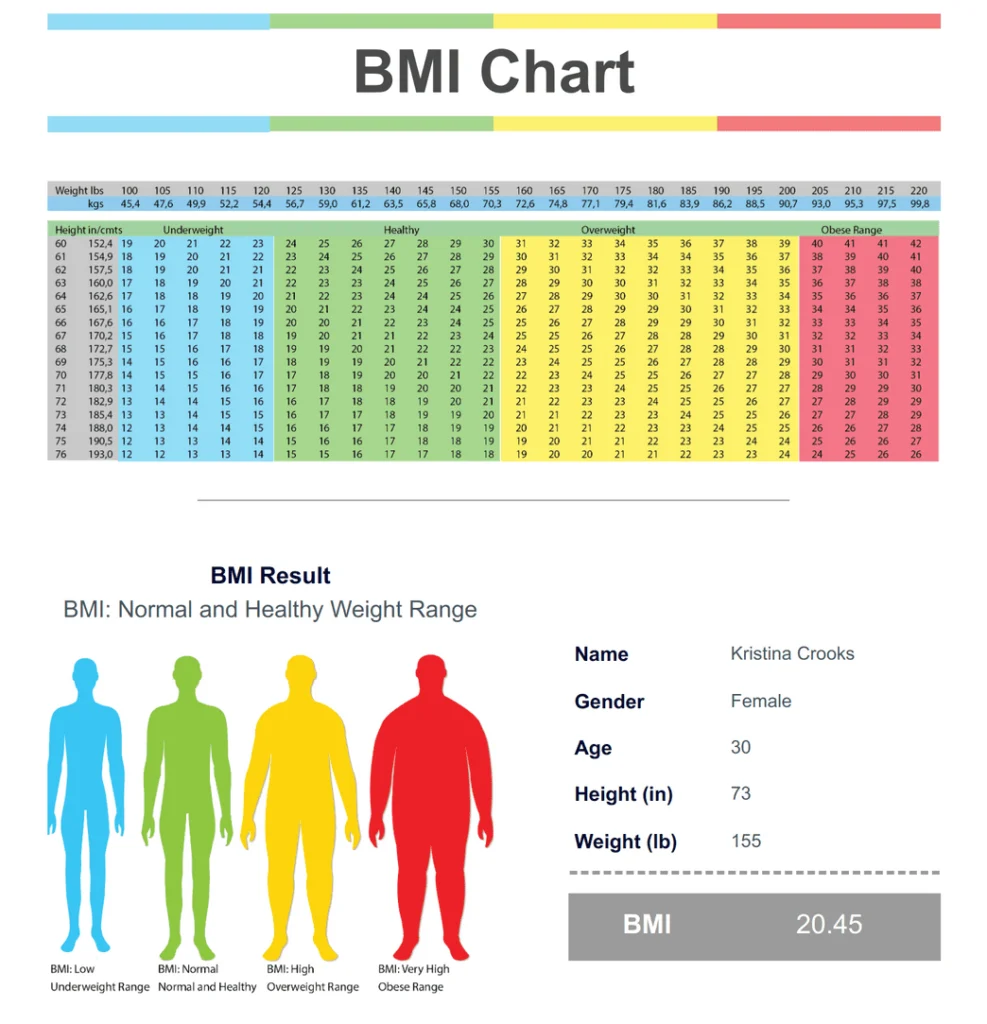BMI for Women
BMI for Women
Body Mass Index (BMI) is one of the most common tools used to assess whether an individual has a healthy weight for their height. While BMI is a general metric used for both men and women, there are specific considerations for BMI for women, especially since women’s bodies tend to have different muscle mass, fat distribution, and hormonal factors compared to men.
What is BMI?
BMI (Body Mass Index) is a simple calculation used to assess whether an individual has a healthy weight relative to their height. It is calculated using the following formula:
BMI = weight (kg) ÷ height² (m²)
The result is a numerical value that falls into one of the following categories:
Underweight: BMI less than 18.5
Normal weight: BMI 18.5–24.9
Overweight: BMI 25–29.9
Obesity: BMI 30 and above

While BMI is an effective tool for many individuals, it’s important to note that it doesn’t measure body fat directly. It’s a useful indicator of overall health but may not always fully reflect a woman’s body composition, particularly for those with higher muscle mass or a significant amount of body fat.
Why BMI Matters for Women
For women, BMI plays a vital role in understanding health risks related to weight. It can signal issues like fertility challenges, hormonal imbalances, and even increased risks of chronic illnesses. While it’s not perfect, it’s a useful first checkpoint in managing your wellness.
Why is BMI Important for Women?
For women, maintaining a healthy BMI is important for several reasons:
Risk of Chronic Diseases: Both being underweight and overweight can increase the risk of developing serious health conditions, including heart disease, diabetes, stroke, cancer, and joint problems.
Hormonal Health: BMI can also influence hormonal balance. For example, being underweight may affect menstruation and fertility, while being overweight or obese can lead to insulin resistance, increased risk of polycystic ovary syndrome (PCOS), and menopausal symptoms.
Pregnancy and Fertility: Maintaining a healthy weight and BMI is critical for fertility and a healthy pregnancy. Women who are overweight or underweight may face complications such as difficulty conceiving, gestational diabetes, or high blood pressure during pregnancy.
Bone Health: Osteoporosis is a common condition in women, especially as they age. Maintaining a healthy BMI can help support bone density, while being underweight may increase the risk of bone loss.
Mental Health and Self-Esteem: There is also an important connection between BMI, body image, and mental health. Maintaining a weight that feels right for you can positively affect self-esteem and reduce stress and anxiety related to body image.
BMI Categories for Women
BMI categories help classify women’s weight status and provide a general indication of their risk for health problems. Here are the categories:
Underweight (BMI < 18.5):
Being underweight can be dangerous for women, as it may lead to nutritional deficiencies, weak immune function, hormonal imbalances, and osteoporosis. It can also affect menstruation and fertility.
Normal Weight (BMI 18.5–24.9):
A BMI within this range is considered healthy for most women. It suggests that the woman has a healthy weight and is at lower risk for weight-related health conditions like heart disease, diabetes, and joint issues.
Overweight (BMI 25–29.9):
Women in this range may be at risk for developing high blood pressure, type 2 diabetes, sleep apnea, and heart disease. Achieving and maintaining a healthy weight is typically recommended, which may involve dietary adjustments and regular physical activity.
Obesity (BMI ≥ 30):
Obesity is linked to a higher risk of chronic diseases, including diabetes, heart disease, stroke, and cancer. Women with a BMI in this category may need to consult a healthcare provider for a comprehensive weight management plan that includes diet, exercise, and possibly medical intervention.
Challenges of BMI for Women
While BMI is a useful tool, it has its limitations, particularly when used to assess women’s health. Some of the main challenges include:
Muscle Mass:
Women typically have less muscle mass than men. Since muscle weighs more than fat, women with high muscle mass (such as athletes or bodybuilders) may have a higher BMI but a low body fat percentage. In these cases, BMI can incorrectly categorize them as overweight or obese, even though they are fit and healthy.
Body Fat Distribution:
Women tend to store fat around their hips, thighs, and lower abdomen. This is normal and influenced by hormones. However, it’s important to note that visceral fat, which accumulates around the abdomen and organs, can be particularly dangerous. BMI does not differentiate between types of fat or provide insight into fat distribution.
Age and Hormonal Changes:
As women age, especially during menopause, hormonal changes may lead to weight gain and shifts in fat distribution. This can result in an increased risk of metabolic conditions like type 2 diabetes and heart disease, even if BMI remains within the “normal” range.
Bone Density:
Women, especially older women, are at risk for osteoporosis, a condition where bones become weak and brittle. Since BMI does not account for bone density, women with lower bone mass may have a lower weight and appear underweight, even though they may be healthy in terms of fat and muscle mass.
Additional Health Measures for Women
Because BMI doesn’t give a complete picture of a woman’s health, it’s important to consider other measures and factors:
Waist Circumference:
Measuring the waist is a great way to assess abdominal fat, which is more dangerous than fat in other areas of the body. A waist measurement greater than 35 inches (88 cm) in women can increase the risk of metabolic conditions and cardiovascular disease.Waist-to-Hip Ratio:
This ratio compares waist circumference to hip circumference. A higher ratio (above 0.85) indicates an increased risk for heart disease and other metabolic conditions.Body Fat Percentage:
Using methods like bioelectrical impedance scales, calipers, or DEXA scans, body fat percentage offers a more accurate measure of body composition than BMI alone. Women with a higher percentage of body fat, even with a “normal” BMI, may be at risk for obesity-related health issues.Physical Fitness:
Factors like cardiovascular fitness, muscle strength, and flexibility can all be better indicators of health than BMI alone. A woman who is fit, strong, and active may be in much better health than someone with the same BMI but with a sedentary lifestyle.
How to Maintain a Healthy BMI for Women
To maintain a healthy BMI, it’s important to focus on overall health rather than just the number on the scale. Here are some tips for women:
Eat a Balanced Diet:
Focus on whole, nutrient-dense foods like fruits, vegetables, lean proteins, whole grains, and healthy fats. Avoid excessive amounts of processed foods, refined sugars, and unhealthy fats.Stay Active:
Regular exercise is essential for maintaining a healthy BMI and body composition. Aim for at least 150 minutes of moderate-intensity exercise per week, plus strength training exercises twice a week to build and maintain muscle.Focus on Strength Training:
As women age, they naturally lose muscle mass. Strength training helps maintain muscle mass, boost metabolism, and support overall body composition.Monitor Portion Sizes:
Be mindful of portion sizes, especially when eating out or consuming calorie-dense foods. This can help avoid overeating and manage weight more effectively.Sleep Well:
Adequate sleep is essential for overall health, weight management, and stress reduction. Aim for 7-9 hours of quality sleep per night.

Conclusion: BMI as a Tool for Women’s Health
BMI for women is a useful tool for assessing weight in relation to height, but it should not be relied upon as the sole indicator of health. Women’s bodies undergo unique changes throughout life, from hormonal fluctuations to changes in muscle mass, fat distribution, and bone density. A holistic approach that includes not only BMI but also body fat percentage, physical fitness, waist circumference, and overall well-being will provide a clearer picture of health.
By maintaining a balanced diet, staying active, and managing stress, women can achieve and maintain a healthy BMI and overall well-being, promoting a long and healthy life.
Check Your BMI Instantly – It's Free
Calculate your Body Mass Index in seconds using our powerful online BMI calculator. Know your health status and take control today — no sign-up required!